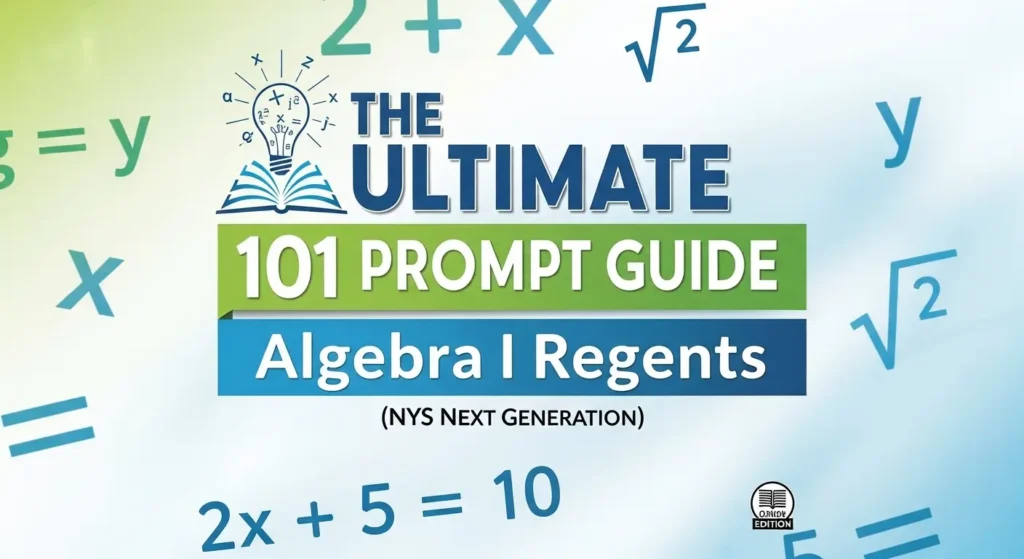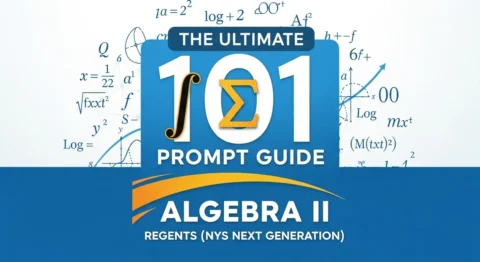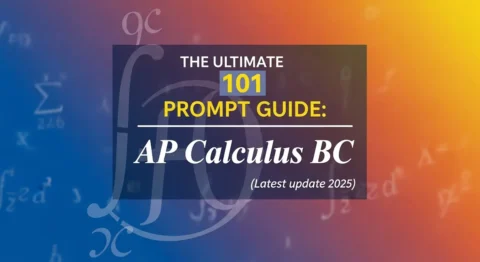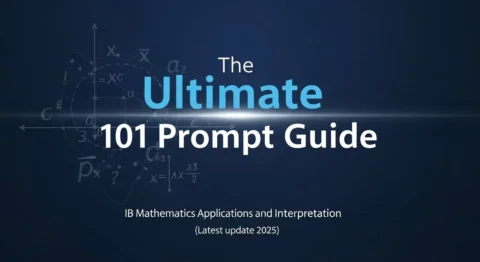Algebra I Regents (NYS Next Generation) — 101 Prompt Guide (2025 Edition)
Aligned to the New York State Next Generation Mathematics Learning Standards and the current Algebra I Regents blueprint in effect since June 2024. This guide “bakes in” the official domains (N‑RN, N‑Q, A‑SSE, A‑APR, A‑CED, A‑REI, F‑IF, F‑BF, F‑LE, S‑ID), the test format (Parts I–IV; 35 questions, 82 raw credits), timing (3 hours), allowable tools (graphing calculator + straightedge), and the eight Standards for Mathematical Practice. Use these prompts verbatim (or lightly adapted) in any modern AI assistant.
How this guide works
Who it’s for: Algebra I teachers and students preparing for the Regents Examination in Algebra I (Next Gen).
What you get: 101 role‑aware, output‑specified, curriculum‑tied prompts you can paste into ChatGPT/Claude/Gemini, etc.
Why it’s accurate: Core facts (blueprint, standards, exam parts, tools, PLDs) come from NYSED’s Educator Guide, Reference Sheet, Information Booklet for Scoring, and Next Generation Mathematics Standards.
Quick curriculum snapshot (for context)
Conceptual categories & % of test by credits:
Number & Quantity (N‑RN, N‑Q) 4–10% • Algebra (A‑SSE, A‑APR, A‑CED, A‑REI) 48–61% • Functions (F‑IF, F‑BF, F‑LE) 24–32% • Statistics & Probability (S‑ID) 7–15%.Exam design: Part I (24 MC, 2 credits each) • Part II (6 CR, 2 credits) • Part III (4 CR, 4 credits) • Part IV (1 CR, 6 credits) • Total: 35 Qs, 82 raw credits • 3 hours • Graphing calculator required; Next Gen Algebra I Reference Sheet provided.
Practices: MP1–MP8 (make sense of problems; reason abstractly; construct arguments; model; use tools; attend to precision; use structure; express regularity).
SECTION 1 — Educator Prompts (50)
Grouped by Planning → Delivery → Assessment → Enrichment. Each prompt is cut‑and‑paste ready. Replace bracketed fields.
A. Planning (13 prompts)
E1. Year‑long map (by blueprint)
Role: You are a NYS Algebra I curriculum designer. Task: Build a year‑long pacing map aligned to the Algebra I Regents blueprint (include % weights) and standards codes. Output: Markdown table with columns: Unit, Standards (codes), Weeks, Priority (H/M/L), Regents Weight, Major Assessments. Include checkpoints before January and June exams.
E2. Unit plan — Linear functions (F‑IF, A‑REI, A‑CED)
Design a 2‑week unit on linear functions and systems (slope, intercepts, solving, modeling). Include: daily objectives, success criteria, Do Nows, worked examples, common misconceptions, exit tickets tied to F‑IF.7a, A‑REI.6a, A‑CED.1–3. Output as a table plus printable exit tickets.
E3. Concept map — Expressions & Equations (A‑SSE, A‑REI)
Create a concept map showing how A‑SSE.1–3 supports A‑REI.1, 3, 4ab. Provide a teacher‑facing narrative (≤200 words) and a student‑facing mini‑poster (ASCII diagram).
E4. Standards unpacking (N‑Q)
Unpack N‑Q.1 & N‑Q.3 into student‑friendly learning targets with sample IEP/ELL accommodations. Output: bullet lists + 3 example tasks each (increasing DOK 1→3).
E5. Lesson arc template (MP1–MP8)
Give me a reusable 90‑minute lesson template embedding MP practices (MP1–MP8) with prompts, talk moves, and “productive struggle” checkpoints. Output: checklist + teacher script snippets.
E6. Vocabulary spine (domain by domain)
Produce a standards‑aligned vocabulary list (with student‑friendly definitions) for N‑RN, A‑SSE, A‑APR, A‑REI, F‑IF, F‑BF, F‑LE, S‑ID. Output as CSV (Term, Definition, Linked Standard, Example).
E7. Diagnostic pre‑assessment (whole course)
Author a 25‑item diagnostic covering all domains (weights mirror the blueprint). Include MC (15) and short CR (10). Provide answer key with skill tags (e.g., F‑IF.4; MP.4). Format: Qs then a separate key.
E8. Lab days — Using the Reference Sheet
Plan two “Reference Sheet fluency” days. Create tasks that require choosing the right formula (e.g., growth/decay, axis of symmetry, quadratic formula). Output: station cards + teacher solutions. (Use Next Gen Algebra I Reference Sheet entries.)
E9. Graphing calculator integration
Build a 6‑lesson micro‑sequence to teach strategic calculator use (tables, trace, intersect, residual plots), aligned to F‑IF.6, A‑REI.11, S‑ID.8–9. Include “paper‑first” and “tech‑check” steps.
E10. Regents timeline & milestones
Create a calendar from September to June with interim assessments, cumulative reviews, and mock exams (Part I–IV). Include time for January retakers. Output: month‑by‑month bullets.
E11. Inclusion plan (UDL)
For each unit, add 3 UDL adaptations (multiple means of representation/action/engagement) plus ELL scaffolds (sentence frames for justifying steps per A‑REI.1). Output: table.
E12. Homework policy aligned to PLDs
Draft a homework progression by Performance Level Descriptions (Levels 2–5): sample tasks that demonstrate movement from Level 2→3→4→5 in factoring quadratics and in interpreting functions. Output: 1‑pager policy + two example sets.
E13. Cross‑course links
List quick connections from Algebra I topics to Geometry/Algebra II (e.g., function transformations → rigid motions; exponent rules → logarithms later). Output: mapping table.
B. Delivery (14 prompts)
E14. Launch activity — “What makes it linear?”
Create a 15‑minute warm‑up contrasting tables/graphs/equations/descriptions; students sort into linear/nonlinear with justifications. Output: printable cards + teacher debrief.
E15. Direct instruction script — Completing the square (A‑REI.4a)
Write a concise mini‑lesson (≤12 minutes) that transitions from x²+bx=n to (x−p)²=q, then applies to y=ax²+bx+c with a=1, b even. Include checks for understanding.
E16. Guided practice set — Factoring (A‑SSE.3c, A‑APR.1)
Generate 12 problems: GCF, difference of squares, trinomials with a=1, and exponent rules in context of exponential forms. Provide step‑by‑step keys.
E17. Think‑aloud — Interpreting parameters (F‑LE.5)
Produce a teacher think‑aloud modeling how to interpret a and b in f(x)=ab^x (growth vs. decay) using real‑world examples. Include a misconception “diagnostic moment.”
E18. Co‑teaching playbook
For systems of equations (A‑REI.6a), design parallel stations: elimination, substitution, graphing. Include roles for general ed/special ed teacher and rotation timing.
E19. Structured discussion — MP3
Create debate prompts where students must justify the best method to solve a quadratic (graphing vs. factoring vs. quadratic formula) for different contexts.
E20. Error analysis gallery
Provide 10 common Algebra I errors (e.g., misusing exponent rules; unit rate mistakes; sign errors solving inequalities). Students annotate: “Find it → Fix it → Generalize it.” Output: poster set.
E21. Problem‑based task — S‑ID.7–9
Give a dataset and ask students to construct a scatter plot, fit a line (informal regression), interpret slope/intercept, and critique strength of fit. Provide teacher rubric.
E22. Multi‑representation routine
For F‑IF.7, build a routine cycling: table → graph → equation → context. Include exemplars for linear, quadratic, exponential, absolute value.
E23. Quick checks (2 minutes each)
Produce 20 micro‑exit slips (one per standard cluster). Output: single‑question slips + answer bank.
E24. Retrieval practice spiral
Create 8 weekly “spirals” mixing prior units with the current one. Each: 6 MC (Part I‑style) + 1 short CR (Part II‑style).
E25. Visual supports
Design three anchor charts: (1) “From words to A‑CED equations,” (2) “Choosing methods to solve A‑REI,” (3) “Reading function features F‑IF.”
E26. Language supports
Generate sentence frames for mathematical arguments (MP3) and precision (MP6) across 10 common tasks (e.g., “The solution is not viable because…”).
E27. Lab — Piecewise & absolute value (F‑IF.7b)
Hands‑on stations to build piecewise graphs from scenarios (cell plans, taxi fares). Include matching cards: scenario ↔ graph ↔ formula.
C. Assessment (12 prompts)
E28. Regents‑style exam generator
Create a full mock Algebra I exam exactly mirroring the blueprint: Part I (24×2), Part II (6×2), Part III (4×4), Part IV (1×6). Include an answer key with brief rationales and a raw‑to‑scale score lookup placeholder.
E29. Part‑by‑part item bank
Write 60 fresh Part I items (tagged by standard and DOK), 30 Part II, 16 Part III, 6 Part IV. Output: spreadsheet‑ready table with fields: ID, Part, Credits, Standard, Stem, Answer/Key, Distractor Rationale (for MC).
E30. Constructed‑response rubrics (2/4/6 credits)
Draft analytic rubrics aligned to NYSED scoring guidance (credit for reasoning, accuracy, units when required, and work shown). Include exemplar responses at Levels 2–5.
E31. PLD‑aligned re‑assessment
Design mini‑assessments that differentiate tasks at PLD Levels 2–5 for quadratic solving and interpreting functions. Provide “move‑up” feedback scripts.
E32. Calculator‑neutral vs. calculator‑active items
Produce 20 paired problems (same concept) where one is paper‑pencil and one expects calculator features (trace/intersect). Tag the standard.
E33. Standards coverage audit
Given a list of past quizzes, output a gap report by code (what’s under‑assessed vs. blueprint targets). Format: heat map matrix (describe color legend).
E34. Exit ticket pack (Regents samplers)
For each domain, create 5 exit tickets that resemble Parts II/III tasks and include “show work” prompts and unit expectations (when applicable).
E35. Data tracker (class & student)
Generate an assessment tracker template that maps raw → scale scores per admin (with notes that conversion charts vary by exam). Provide conditional formatting rules.
E36. Item analysis playbook
Write procedures to analyze distractor patterns on Part I and rubric trends on constructed responses; include action steps per misconception.
E37. Speaking/listening checks for math
Develop oral probes (1–2 minutes) to verify conceptual understanding for A‑REI.1 (explain steps), F‑IF.4 (interpret features), S‑ID.9 (correlation vs. causation).
E38. Performance task — Modeling (★)
Design a 45‑minute modeling task (MP4) that spans A‑CED + F‑LE with real data; include criteria for success and argument‑writing prompts (MP3).
E39. Quarter benchmark (cumulative)
Create three cumulative benchmarks (Q1, Q2, Q3) with blueprint‑aligned weights and mixed‑part items; provide conversion to suggested grades.
D. Enrichment (11 prompts)
E40. Extensions for early finishers
Produce 30 challenge prompts connecting functions to coding (e.g., transformations as mappings), economics (linear models), and physics (quadratic trajectories).
E41. Math circle session — Structure (MP7)
Plan a 50‑minute session on recognizing structure in expressions (A‑SSE.2) with puzzles that reveal factoring shortcuts.
E42. Careers mini‑profiles
Create 8 mini‑profiles showing how data modeling (S‑ID) and exponential growth (F‑LE) appear in real jobs; each includes a 2‑problem application.
E43. Family math night kit
Provide stations with hands‑on activities: linear modeling with rubber bands, exponential decay with M&M sampling, histogram creation. Include signage and take‑home sheets.
E44. Cross‑disciplinary projects
Draft 4 project briefs: (1) Biology population models (F‑LE), (2) Budget planning (A‑CED), (3) Sports analytics (S‑ID), (4) Art of symmetry via quadratics (F‑IF).
E45. Math journaling prompts
Give 20 journaling prompts aligned to MP1/MP3/MP6 that elicit reflection on strategies and precision.
E46. Contest‑style problems
Generate 12 non‑routine tasks within Algebra I scope (no Algebra II prereqs), each with hints, full solutions, and extension questions.
E47. “Reference Sheet masterclass”
Create a gamified activity where students earn badges for correctly choosing when to use the formula vs. deriving it, with scenarios.
E48. Visual proofs (where appropriate)
Develop visual/verbal proofs for slope formulas and completing the square; include teacher notes on when to use them to deepen understanding.
E49. Student‑created question protocol
Give a protocol for students to write Regents‑style items: checklist for standards tagging, distractor design, and rubric drafting.
E50. Community data project
Plan a class project to collect local data (walking times, cafeteria lines), analyze with S‑ID, fit linear models, and present findings.
SECTION 2 — Student Prompts (50)
Grouped by Understanding → Practicing → Revising → Preparing for assessment. Paste a prompt directly into your AI tool and insert your details.
A. Understanding (13 prompts)
S1. Explain it to me like I’m new (A‑SSE.1)
Role: You are my Algebra I tutor. Task: Explain how to read each part of an expression (term, coefficient, factor, constant) using A‑SSE.1a/b. Output: 150‑word explanation + 3 labeled examples.
S2. From words to equations (A‑CED.1–3)
Turn these word problems into equations/inequalities in one or two variables. Show how each term maps to the story. Output: steps + final equation + quick check.
S3. Linear vs. nonlinear (F‑IF.7)
Given 6 representations (equations, graphs, tables), classify linear, quadratic, exponential, or absolute value and justify. Output: table with Reason column.
S4. Why the quadratic formula works (A‑REI.4b)
Give me a conceptual walk‑through (no heavy algebra) relating completing the square to the quadratic formula. Output: 5 bullet steps + a small numeric example.
S5. Units that make sense (N‑Q.1,3)
Explain how to choose units and levels of precision for real‑life measurements (money, distance, time). Include two “too precise” vs. “not precise enough” cases.
S6. What does slope mean? (F‑IF.6)
Using a table, a graph, and a context (you choose), show average rate of change and interpret it. Output: tri‑pane view with brief captions.
S7. Growth vs. decay (F‑LE.1,3,5)
Compare linear and exponential situations. Give me a quick test for deciding which model applies, then interpret parameters in f(x)=ab^x.
S8. Systems sense‑making (A‑REI.6a,11)
Show how the solution to a system is the intersection point(s). Do one by graphing and one by solving. Explain when each method is better.
S9. Polynomial operations (A‑APR.1)
Explain how adding, subtracting, and multiplying polynomials stays within the “polynomial system.” Give 3 examples with “check your work.”
S10. Zeros and factors (A‑APR.3)
Explain how zeros relate to factors, and how factored form helps you read a graph’s x‑intercepts. Include one cubic where factors are given.
S11. Reading function features (F‑IF.4,7)
Given a graph, identify intercepts, zeros, intervals of increase/decrease, maxima/minima, and symmetry. Output: annotated list.
S12. Scatter plots & lines (S‑ID.7–9)
Explain correlation vs. causation, how to sketch a line of best fit, and what slope/intercept mean in context.
S13. Reference Sheet tour
Walk me through every formula on the Next Gen Algebra I Reference Sheet with a “use‑this‑when…” sentence for each. Keep it concise.
B. Practicing (13 prompts)
S14. 10‑minute drill — Linear basics
Give me 8 practice problems on slope, intercepts, and writing equations from two points. Provide an answer key with one‑line justifications.
S15. Factoring ladder
Create a 12‑problem set that progresses: GCF → difference of squares → trinomials with a=1. Include hints after every 3 problems.
S16. Quadratic solving mixed
Mix factoring, completing the square, and quadratic formula (identify the best method). Provide full solutions.
S17. Word problems to models (A‑CED)
Give 6 real‑world modeling problems (tickets, taxi fares, cell plans). I’ll write equations; you check for units and reasonableness.
S18. Average rate of change (F‑IF.6)
Provide 5 graphs/tables to compute and interpret average rate of change over intervals.
S19. Function transformations (F‑BF.3a)
Practice set: describe effects of f(x)+k, f(x−h), −f(x), af(x) on linear and quadratic functions. Include 2 sketch prompts.
S20. Systems practice trio
Create 9 systems (3 per method: substitution, elimination, graphing). Tag each with a quick method tip.
S21. Exponential applications (F‑LE.2,5)
Give 6 problems constructing exponential/linear models from data points or descriptions. Include parameter interpretation.
S22. Data & residuals (S‑ID.8–9)
Provide a dataset; fit a line (informal), compute residuals, interpret what a residual means for two sample points.
S23. Inequalities on a graph (A‑REI.12)
Give 5 tasks graphing linear inequalities and systems of inequalities, shading correctly. Include a viability check for points.
S24. Literal equations (A‑REI.3)
Practice isolating a variable in multi‑step formulas. Provide 8 items with increasing complexity.
S25. Sequence sense (F‑BF.1a)
Write explicit forms of arithmetic and geometric sequences (including from context). 8 problems, with one reflection: “Why is a geometric sequence exponential?”
S26. Mixed mini‑set (all domains)
10 MC questions sampling every domain per blueprint weights; provide key + brief rationales.
C. Revising (12 prompts)
S27. My error log
Analyze 10 of my past mistakes. Cluster them (concept, procedure, units, calculator misuse). Give me “if you see this, try this” strategies.
S28. One‑pager summaries
For five most challenging topics I name, generate concise one‑pagers with definitions, examples, and a mini self‑quiz.
S29. Formula choosing flowchart
Create a flowchart helping me decide among factoring, completing the square, or quadratic formula — with quick checks for each.
S30. Vocabulary flashcards (spaced)
Generate 40 flashcards (term on front, definition + example on back), scheduled over 2 weeks using spacing.
S31. Reference Sheet mastery quiz
Give a 12‑item quiz that forces me to pick the correct formula from the Reference Sheet; include immediate feedback.
S32. “Teach it back” scripts
Write short scripts for me to teach a peer: (a) interpreting slope, (b) completing the square, (c) correlation vs. causation.
S33. Unit recap questions
Produce 20 “why” questions (not just “how”) for linear models and systems; I’ll answer in full sentences.
S34. Mini‑proof prompts (A‑REI.1)
Give 6 prompts where I justify algebraic steps using properties (e.g., addition property of equality).
S35. Confuser sets
Give me look‑alike problems (exponential vs. power vs. linear) and ask me to identify and justify.
S36. Graph features scavenger hunt
Provide 10 small graphs; I must label features (intercepts, zeros, intervals, vertex) quickly and accurately.
S37. Units & precision clinic (N‑Q)
Create a set of 8 measurement/reporting items where I must choose appropriate units and precision, explaining my choice.
S38. Regents vocabulary check
List 50 Regents‑style verbs (“determine,” “justify,” “state,” “model”) with what they expect in an answer.
D. Preparing for assessment (12 prompts)
S39. Personal study plan (blueprint‑aware)
Using the official blueprint percentages, build me a 3‑week plan with daily goals, alternating content and mixed review. Output: calendar grid.
S40. Part I sprint
Generate 24 new Part I multiple‑choice questions, blueprint‑balanced, with keys and one‑line rationales.
S41. Parts II–IV sampler
Create 6×2‑credit, 4×4‑credit, and 1×6‑credit constructed responses on my weak areas; include complete model solutions.
S42. Exam day checklist
Make a checklist for materials, calculator reset, reference‑sheet familiarity, time management, and “show work” habits.
S43. Time‑boxed practice
Simulate exam pacing: 40 min for Part I, 30 min for Part II, 35 min for Part III, 35 min for Part IV. Provide a proctor script and time calls.
S44. Self‑scoring guide
Give a self‑scoring rubric for my constructed responses (2/4/6), with “how to earn the next credit” notes.
S45. Calculator strategy sheet
Summarize when to use table/graph/intersect, and common pitfalls (window settings, rounding). Tie to F‑IF.6 and A‑REI.11.
S46. Last‑mile misconceptions
List the 20 most common last‑week errors (inequality direction, domain issues, misuse of exponent rules) and quick fixes.
S47. Mixed mock (new items)
Build a full mock exam (all parts) from unseen items; keep the same structure as the official test. Provide raw score only; I’ll convert on rating day.
S48. Reflection form
Create a reflection form for after the mock: confidence per domain, time analysis, target fixes.
S49. “Explain your steps” rehearsal (A‑REI.1)
Give me 5 problems where the grading focuses on written justification of steps — not just answers.
S50. Night‑before light review
Provide a 60‑minute plan: 20 min Part I mixed, 20 min features of functions, 10 min calculator drill, 10 min Reference Sheet flash.
SECTION 3 — Bonus Universal Prompt (1)
U1. Interdisciplinary modeling studio (creative)
Role: You are a cross‑disciplinary coach (math + science + social studies). Task: Design a 5‑day mini‑project where students: gather real data, model with A‑CED/F‑LE, analyze with S‑ID, and communicate findings (MP4, MP6). Output: Day‑by‑day plan with deliverables (1‑page brief, graph set, oral defense), rubrics aligned to PLDs Level 3→4→5. Include calculator and Reference Sheet checkpoints.
Why you can trust this guide
Standards & domains: NYS Next Generation Mathematics Learning Standards (high school Algebra I section).
Blueprint & exam parts: Educator Guide to the Regents Examination in Algebra I (Updated Oct 2023): domains, % by credits, Parts I–IV, credits, timing, calculator & tools.
Reference formulas: Next Generation Algebra I Reference Sheet (for use starting June 2024).
Scoring & constructed‑response practices: Information Booklet for Scoring the Regents Examination in Algebra I (updated for 2024 administrations).
Current exam format confirmation: Regents Algebra I operational exams (e.g., June 2025 form states “four parts, total of 35 questions”).





